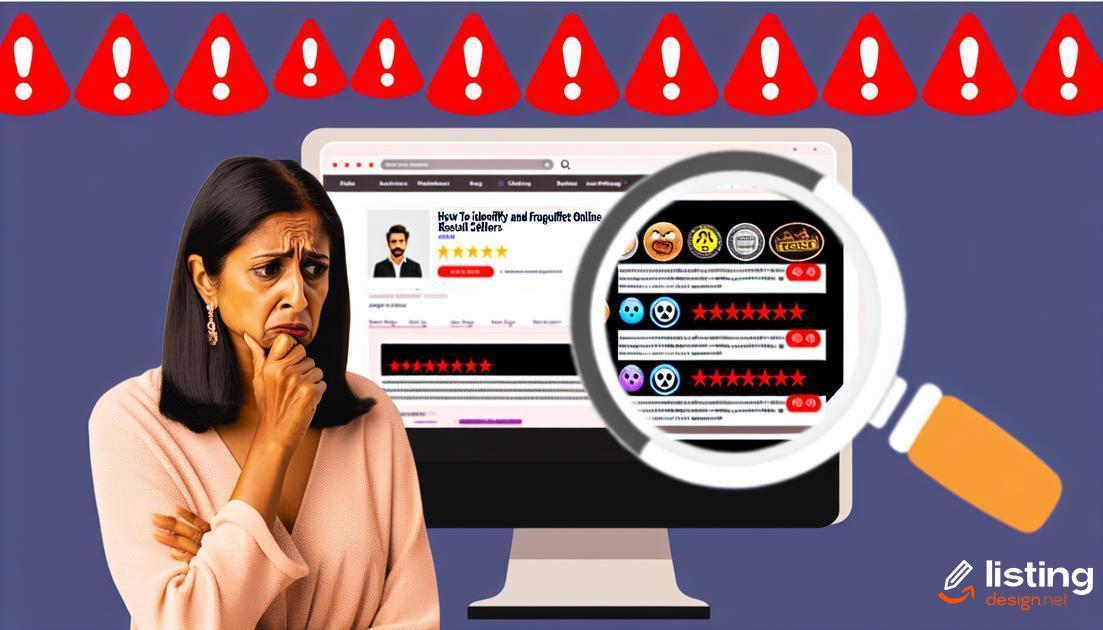Scam Amazon sellers are becoming increasingly sophisticated, making it crucial for shoppers to stay vigilant. In this post, we will delve into the various tactics used by scammers, how you can identify a suspicious seller, and the steps you can take to safeguard your purchases. With more people shopping online, understanding these scams is essential to ensuring a safe and pleasant shopping experience.
Table of Contents
Understanding Scam Amazon Sellers
Recognizing scam Amazon sellers is essential to ensure that you do not fall victim to fraudulent activities. These sellers often employ various tactics to deceive buyers and exploit the platform’s reach. It is crucial to stay vigilant and informed to avoid potential losses.
Scam sellers may create counterfeit listings, offer non-existent products, or sell items at prices that seem too good to be true. They often use fake feedback to boost their credibility and lure unsuspecting customers. Sometimes, the products may be low-quality knock-offs, significantly different from what was advertised.
Reviewing seller profiles can offer valuable insights. Look for detailed seller information, including their history, ratings, and customer feedback. Scam sellers often have new or unverified accounts with limited information available.
Analyze the pricing: Extremely low prices compared to other sellers can be a red flag. While discounts and competitive pricing are common, prices that seem unusually low should be approached with caution.
Check the shipping details: Fraudulent sellers might provide vague or unusual shipping estimates. Be wary of listings with extended shipping times or inconsistent delivery information.
Scrutinize product descriptions: Authentic sellers usually provide comprehensive and accurate product descriptions. Be cautious of listings with generic, poorly written, or overly brief descriptions, which can indicate a scam.
Common Types of Scams on Amazon

Amazon, being a massive online marketplace, is unfortunately also a target for various types of scams. It’s crucial to be aware of these to protect yourself while shopping.
Fake Products
One of the most common scams on Amazon involves counterfeit or fake products. Scammers create listings that appear to be genuine but sell products that are often subpar knock-offs. These can range from electronics to fashion items.
Missing Items
Some fraudsters send packages that don’t contain the items the buyer ordered, or the packages could be empty altogether. This scam usually targets high-value items to maximize the scammer’s profit.
Price Gouging
During times of high demand, some sellers may engage in price gouging. They significantly raise the prices of in-demand items, exploiting consumers’ urgent need for these products.
Phishing Links
Scammers might also include phishing links in product descriptions or seller messages. Clicking these links can lead to malicious websites designed to steal your personal information.
Shipping Scams
In some cases, sellers might mark an order as shipped without actually sending the product. They may provide fraudulent tracking information to complicate matters further.
Switch and Return
Dishonest sellers may send an inferior item instead of what was advertised, hoping the buyer won’t go through the hassle of returning it. This tactic is sometimes referred to as a switch and return scam.
Staying vigilant and informed about these common types of scams on Amazon can help you avoid falling victim and ensure a safe shopping experience.
Signs of a Fraudulent Amazon Seller
- One of the first red flags is an unusually low price for a product. If the deal seems too good to be true, it probably is.
- Check the seller’s reviews. A fraudulent seller might have many negative reviews or even suspiciously positive ones.
- Look at the seller’s account age. New accounts with little to no history could be a scam risk.
- Pay attention to the number of products listed. Scam sellers often have a very small inventory or an oddly eclectic catalog.
- Examine product descriptions. Poorly written descriptions and low-quality images may indicate a scam.
- Check the seller’s return policy. A vague or unusually strict return policy can be a sign of fraud.
- Look for contact information. Trustworthy sellers usually provide clear contact details; a lack of this info can be suspicious.
- Be wary if the seller pressures you to complete the purchase quickly or outside of Amazon’s platform.
How to Verify Amazon Seller Authenticity

Ensuring the authenticity of an Amazon seller is crucial to avoid scams. Start by checking their seller profile. An established seller will have a detailed profile with a professional presentation. Look for their business information and contact details. Watch out for new sellers with limited information or freshly created accounts, as these can be more prone to fraudulent activities.
Next, analyze their product listings. Authentic sellers often provide comprehensive descriptions, high-quality images, and complete details about their products. If the information is sparse or looks unprofessional, this could be a red flag.
Customer reviews and ratings also play a significant role. Authentic sellers tend to have a mixture of positive and negative reviews, which indicates genuineness. Be cautious if you notice an unusual pattern of overly positive reviews with similar wording, as this might suggest manipulated feedback.
Investigate their performance metrics and feedback scores. Authentic sellers typically maintain high ratings with feedback metrics visible in their profiles. Poor performance metrics or hidden feedback can be indicative of unreliable sellers.
Consider contacting the seller directly with questions about the product. Genuine sellers will respond promptly and professionally. Lack of response or evasive answers can serve as warning signs.
Lastly, verify if the seller uses Amazon’s Fulfillment by Amazon (FBA) service. Sellers using FBA are more likely to be trusted since their products are stored and shipped by Amazon itself, adding an additional layer of quality control.
Customer Reviews and Ratings Accuracy
One of the key components in identifying fraudulent sellers on Amazon is understanding the accuracy of customer reviews and ratings. Fake reviews are a common tactic employed by scammers to build a misleading reputation. These reviews can be generated by bots or purchased from review farms. Although Amazon employs sophisticated algorithms to detect fake reviews, some may still slip through the cracks.
When assessing reviews, pay close attention to the language used. Fake reviews often contain generic phrases and exhibit a pattern of repetitive language. Conversely, legitimate reviews tend to be more detailed and specific about the product’s performance.
Another red flag is an overwhelming number of five-star ratings within a short time frame. While it’s possible for new products to quickly gain popularity, a sudden surge in glowing reviews should be viewed with caution. Read through some of the lower-rated reviews as well, as they often provide insight into genuine issues with the product.
Verified Purchase Badges
Look for reviews marked with the Verified Purchase badge. This signifies that the reviewer has actually purchased the product through Amazon, making these reviews generally more trustworthy. However, be aware that even Verified Purchase reviews can be manipulated, so use this as one of several criteria in your evaluation.
It’s also useful to check the reviewer’s history. Profiles that have only reviewed one product or a cluster of products with similar praise may indicate suspicious activity. Trustworthy reviewers usually have a varied history and their feedback across different products should maintain a consistent, credible tone.
Protecting Yourself from Scams

When dealing with potential scams, vigilance is key. Always start by scrutinizing seller profiles. Look for complete profiles with a detailed history of transactions. Avoid sellers with limited information, incomplete contact details, or a high volume of negative feedback.
Be cautious of prices that seem too good to be true. Scammers often lure buyers with extremely low prices. Compare prices with other sellers to ensure consistency and legitimacy.
Another critical step is to examine product descriptions and images. Authentic sellers provide comprehensive and accurate information about their products. Watch out for vague descriptions, poor-quality photos, or copied content from other listings.
Utilize Amazon’s customer service resources. Report any suspicious activity directly to Amazon. They have systems in place to investigate and often take swift action against fraudulent sellers.
Always use secure payment methods through Amazon’s platform. This ensures that your transaction is protected under Amazon’s policies and prevents scammers from accessing your payment information.
By following these steps, you can significantly reduce the risk of falling victim to scams and enhance your overall shopping experience on Amazon.
Amazon’s Role in Preventing Scams
Amazon plays a crucial role in mitigating scams through a robust set of policies and tools designed to detect and prevent fraudulent activities. Advanced algorithms are employed to flag suspicious behavior. Sellers who exhibit unusual patterns or receive frequent complaints are quickly identified and investigated.
Proactive Monitoring
Amazon uses sophisticated machine learning models to continually monitor transactions and seller behavior. This proactive approach helps in identifying potential scams before they impact customers. Regular audits and checks ensure that sellers comply with Amazon’s policies.
Seller Verification
Amazon requires sellers to go through a stringent verification process, including identity checks and business verification. This process helps filter out fraudulent sellers before they can list products on the platform. Multi-layered verification ensures the authenticity of sellers, protecting buyers from potential scams.
Reporting and Enforcement
Amazon encourages customers to report suspicious activities. Effective customer reporting mechanisms and swift enforcement actions ensure that any reported scams are promptly investigated and resolved. Amazon often bans sellers who violate policies, enhancing the overall safety of the marketplace.
By implementing these measures, Amazon not only protects its customers but also maintains the integrity of its marketplace, ensuring a safer shopping experience for everyone.
Reporting Suspicious Activity

If you suspect suspicious activity when dealing with an Amazon seller, it’s crucial to report it immediately. Amazon has a dedicated team that investigates fraudulent sellers and takes appropriate action to ensure a safe shopping experience for everyone.
To report a seller, visit the Amazon Help page and choose the option to report suspicious activity. You will need to provide specific details, such as the seller’s name, a description of the suspicious behavior, and any order numbers or product listings related to the issue.
When reporting, submit clear and accurate information. The more details you provide, the easier it will be for Amazon to investigate the matter. You can also contact Amazon Customer Service directly for further assistance.
Keep an eye on your account for any updates or requests for more information. Amazon might reach out to you for additional details or to confirm findings based on your report. Remember, acting promptly not only helps you but also protects other customers from potential scams.
Refunds and Returns for Scam Purchases
If you’ve fallen victim to a scam purchase on Amazon, the platform offers various ways to secure refunds and returns. First, visit your order history and locate the fraudulent transaction. Click on ‘Problem with this order’ and select the option that best describes your issue. Amazon’s A-to-z Guarantee protects you by ensuring that you receive purchased items on time and as advertised.
To claim a refund, you may need to fill out an online form detailing your complaint. It’s crucial to provide evidence such as screenshots of the product listing, communication with the seller, and any other relevant information. Amazon typically investigates these claims promptly and can issue refunds directly to your payment method.
In some cases, Amazon may ask you to return the fraudulent items. Make sure you follow their return instructions carefully to ensure a smooth process. If the seller is uncooperative or unresponsive, Amazon’s support team can mediate and enforce their policies.
Always act quickly when you suspect fraudulent activity to increase your chances of a successful resolution. Knowing your rights and the processes involved can significantly mitigate the impact of encountering scam sellers.
Buyer Protection Policies

Refund and Return Policies
One of the primary aspects of buyer protection is understanding the refund and return policies. Amazon has a robust system in place to handle these issues. If you purchase from a third-party seller, the seller’s individual return policies apply. However, Amazon’s A-to-z Guarantee ensures you get your money back if you encounter problems such as:
- Items not received
- Items significantly different from the description
- Defective or damaged products
Make sure you review the seller’s return policy before purchasing, as some might have stricter conditions than others. For items fulfilled by Amazon, the process is more streamlined with a straightforward return system.
Steps to File a Claim
If you’ve had an issue with a purchase, filing a claim under the A-to-z Guarantee is a straightforward process. Follow these steps:
- Contact the seller through your Amazon account and attempt to resolve the issue.
- If the seller does not resolve the problem, go to ‘Your Orders’ and select ‘Problem with order.’
- Provide required details and submit your claim.
Navigating Amazon’s policies effectively ensures you have recourse in the event of encountering a scam seller.
Tools to Monitor Amazon Seller Behavior
When navigating the extensive marketplace on Amazon, it’s essential to stay vigilant about potential scams. One way to do this is by utilizing reliable tools to monitor seller behavior. These tools provide insights that help in identifying suspicious activities and ensure a safer shopping experience.
Fakespot: Fakespot analyzes seller reviews and product listings to detect fake reviews and fraudulent sellers. By examining the review patterns and ratings, Fakespot provides a trust score for each seller, helping buyers make informed decisions.
Keepa: Keepa is a price tracking tool that also offers detailed seller history and product availability insights. By monitoring changes in seller behavior and price fluctuations over time, users can spot irregular activities that might signify scam efforts.
SellerApp: SellerApp provides comprehensive analytics on seller performance. This tool offers data on sales, pricing strategies, and competition. With such insights, buyers can identify unusual behavior or patterns that might indicate a scam seller.
Consumers can also benefit from using Amazon’s built-in tools. The Amazon Seller Profile offers information about the seller, including ratings and feedback. Additionally, the Order Report gives a detailed account of all transactions, making it easier to spot any inconsistencies or red flags.
By leveraging these tools, you can maintain greater control over your shopping experience and stay ahead in spotting possible scams. Ensuring you use these resources effectively not only protects your purchases but also contributes to a more secure marketplace for all users.
Success Stories: Beating the Scammers

Throughout the years, many customers have successfully navigated the challenging waters of fraudulent sellers on Amazon. Their stories of triumph and resilience serve as valuable lessons for others. By staying informed and vigilant, these buyers managed to avoid scams and even recover their funds when faced with deceitful tactics.
One key aspect is the importance of verifying seller authenticity. Buyers who consistently check seller ratings and examine customer reviews—especially focusing on the negative ones—tend to identify potential red flags early on. Analyzing patterns in feedback can reveal inconsistencies that often signal fraud.
Moreover, many successful customers utilize various tools to monitor seller behaviors. These tools help track changes in seller ratings or the sudden appearance of numerous negative reviews, indicating possible issues. Such proactive measures have enabled buyers to make informed decisions and avoid potential scams.
Engaging directly with Amazon’s customer service is another common thread in these success stories. Buyers who report suspicious activity promptly often find Amazon responsive in taking necessary actions against fraudsters. The platform’s buyer protection policies also play a crucial role, offering recourse for those who fall victim to scams. These policies can lead to refunds and returns, mitigating financial losses for the affected customers.
Additionally, many successful buyers highlight the importance of securely conducting transactions. Using payment methods that offer fraud protection can provide an extra layer of security. Implementing these practices has proven effective in safeguarding against scams.


